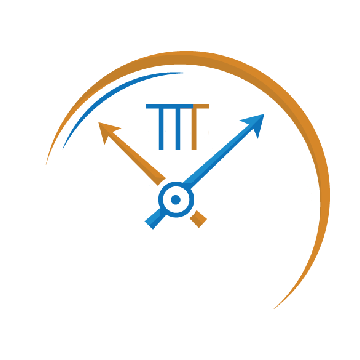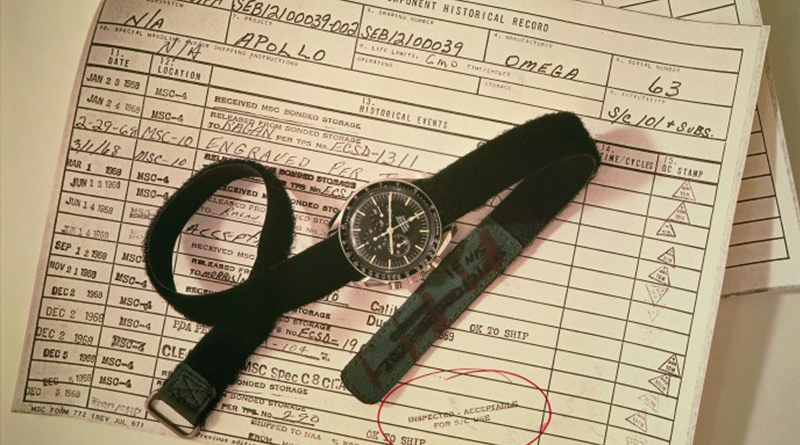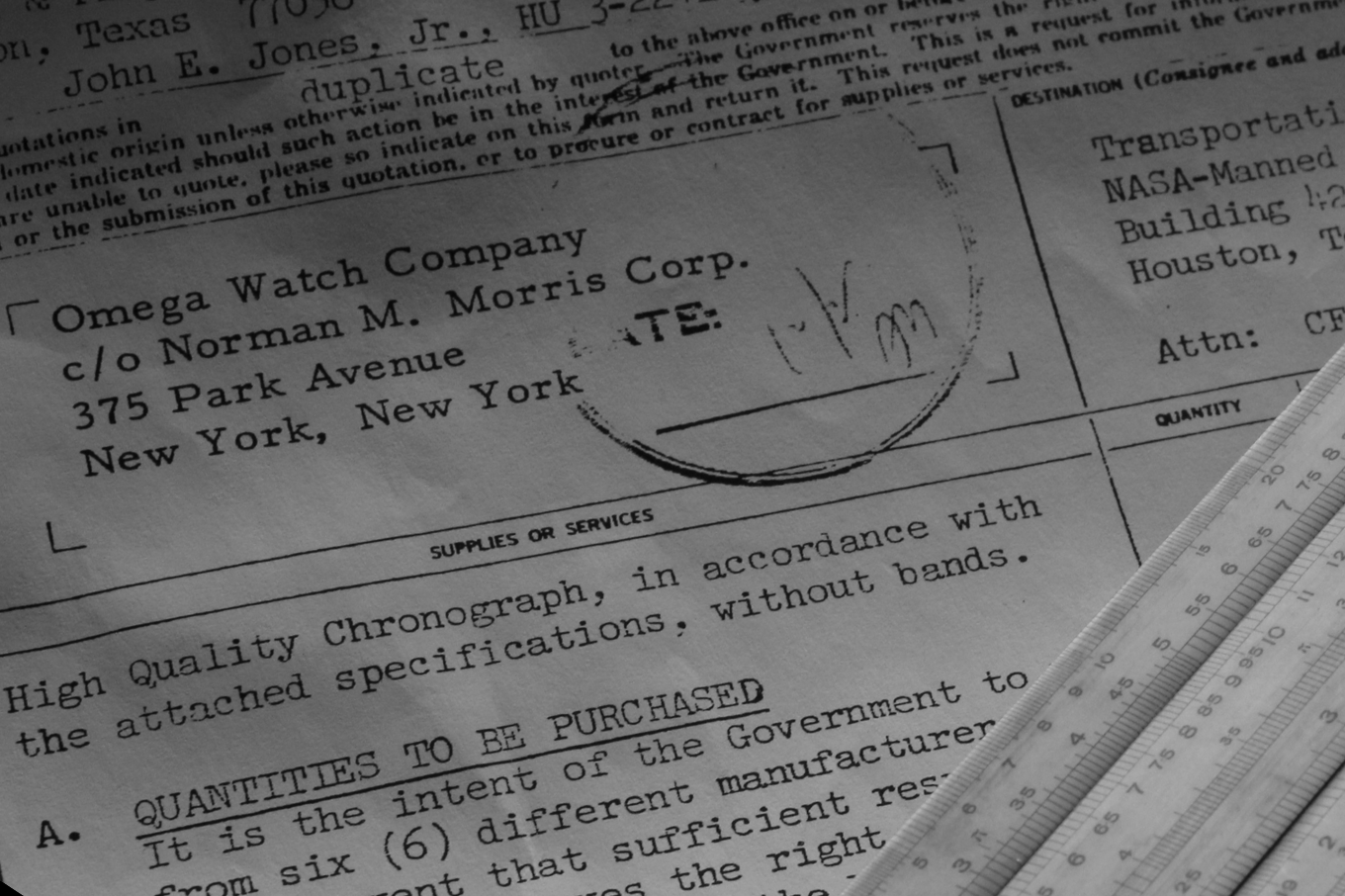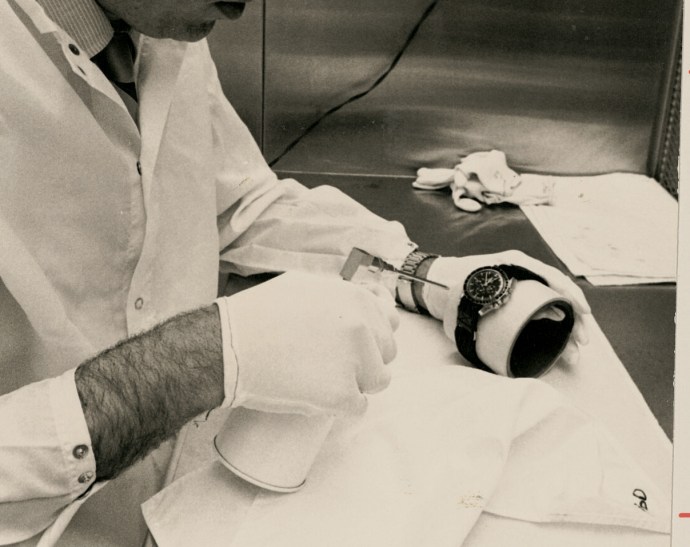NASA Testing Regime for the Omega Speedmaster Moonwatch
How did the Omega Speedmaster become the Moonwatch? The crowning of the Moonwatch started with a “Suggested List of Manufacturers” and a “Statement of Specification” coordinated by NASA astronaut Donald K. “Deke” Slayton and NASA engineer James H. Ragan.
A specification was released by Ragan, then a young engineer at NASA, and Slayton, the Chief of Astronaut Office division, to 10 watch manufacturers whom they believed could provide a watch to meet their requirements. “It was so nebulous that people couldn’t tell what we were going to do with them” Ragan says.
An extract from the September 21, 1964 memorandum which contains a “Suggested List of Manufacturers” was provided to the Procurement and Contracts Division of NASA, requesting a standard chronograph for all NASA astronauts.
SUGGESTED LIST OF MANUFACTURERS:
- Elgin
- Benrus
- Hamilton
- Mido
- Lucien Piccard
- Omega
- Bulova
- Rolex
- Longines
- Gruen
The memorandum continues with a “Statement of Specifications”:
STATEMENT OF SPECIFICATIONS:
- Accuracy – Must not gain or lose more than 5 seconds over a 24 hour period. Desirable to have an accuracy equal to or better than 2 seconds per 24 hours.
- Pressure Integrity – The chronometer must be immune to large variances in pressure to include a range from 50 feet of water positive pressure to a negative pressure of 10 millimeters of mercury.
- Readability – All disks, bands, and figures must be readable in various lighting conditions. The chronograph must be readable under both “red” and “white” lighting conditions to or beyond a 5 foot candle illumination intensity. Either a black face with white figures and numerals or black on white is satisfactory. The chronograph should not cause glare at the high illumination levels. A stainless steel case with a satin finish is preferred.
- The chronograph must have stop-start elapsed dials with
- Seconds to 1 minute
- Minutes to 30 minutes
- Hours to 12 hours or greater.
- The chronograph must be shockproof, waterproof, and anti-magnetic. In addition, the face cover must be shatterproof.
- The chronograph may be powered electrically, manually or the self-winding type; however, it must be capable of being manually wound and re-set.
- Reliability – the Manufacturer must guarantee the watch to operate properly under normal conditions for at least one year time period. Performance data and specifications should be supplied by the manufacturer. Manufacturer guarantee and/or warranty should also be included.
Out of the 10 manufacturers to receive the request, only 4 submit a watch for NASA consideration. The Longines 235T, the Rolex Cosmograph, a Hamilton and the Omega Speedmaster Professional are all received. The Hamilton was discounted prior to testing as it was not a wrist mounted piece.
The first qualification program for the NASA watches was conducted in 1965. To be “flight-qualified by NASA for all manned space missions”, a wrist chronograph must pass all of the following tests numerous times without failure of any kind:
- High Temperature – 48 hours at a temperature of 160°F (71°C) followed by 30 minutes at 200°F (93°C). For the high temperature tests, atmospheric pressure shall be 5.5 psi (0.35 atm) and the relative humidity shall not exceed 15%.
- Low Temperature – Four hours at a temperature of 0°F (-18° C)
- Temperature Pressure Chamber – pressure maximum of 1.47 x 10exp-5 psi (10exp-6 atm) with temperature raised to 160°F (71°C). The temperature shall then be lowered to 0°F (-18°C) in 45 minutes and raised again to 160°F in 45 minutes. Fifteen more such cycles shall be completed.
- Relative Humidity – A total time of 240 hours at temperatures varying between 68°F and 160°F (20°C and 71°C, respectively) in a relative humidity of at least 95%. The steam used shall have a pH value between 6.5 and 7.5.
- Pure Oxygen Atmosphere – The test item shall be placed in an atmosphere of 100% oxygen at a pressure of 5.5 psi (0.35 atm) for 48 hours. Performance outside of specification tolerance, visible burning, creation of toxic gases, obnoxious odors, or deterioration of seals or lubricants shall constitute a failure. The ambient temperature shall be maintained at 160°F (71°C).
- Shock – Six shocks of 40g each, in six different directions, with each shock lasting 11 milliseconds.
- Acceleration – The test item shall be accelerated linearly from 1g to 7.25g within 333 seconds, along an axis parallel to the longitudinal spacecraft axis.
- Decompression – 90 minutes in a vacuum of 1.47 x 10E-5 psi (10 E-6 atm) at a temperature of 160° F (71° C), and 30 minutes at a 200° F (93°C).
- High Pressure – The test item shall be subjected to a pressure of 23.5 psi (1.6 atm) for a minimum period of one hour.
- Vibration – Three cycles of 30 minutes (lateral, horizontal, vertical, the frequency varying from 5 to 2000 cps and back to 5 cps in 15 minutes. Average acceleration per impulse must be at least 8.8g.
- Acoustic Noise – 130dB over a frequency range from 40 to 10,000 HZ, for a duration of 30 minutes.
In a NASA memorandum dated March 1, 1965 the results of its extensive testing was concluded with the following major discrepancies found:
- Rolex – It stopped running on two occasions during the Relative Humidity Test and subsequently failed during High Temperature Test No. 1 when the sweep second hand warped and was binding against the other hands on the dial. No further tests were run with the Rolex chronographs
- Longines Wittnauer – The crystal warped and disengaged during the High Temperature Test. The same discrepancy occurred on a second Longines Wittnauer during Decompression Test No. 8. No further tests were run with Longines Wittnauer chronographs.
- Omega – It gained 21 minutes during the Decompression Test and lost 15 minutes during the Acceleration Test. The luminescence on the dial was destroyed during testing. At the conclusion of all testing the Omega chronograph operated satisfactorily.
On June 1st, 1965 the Omega Speedmaster Professional (Ref. 105.003) received the official NASA certifical for use during manned space missions. 




